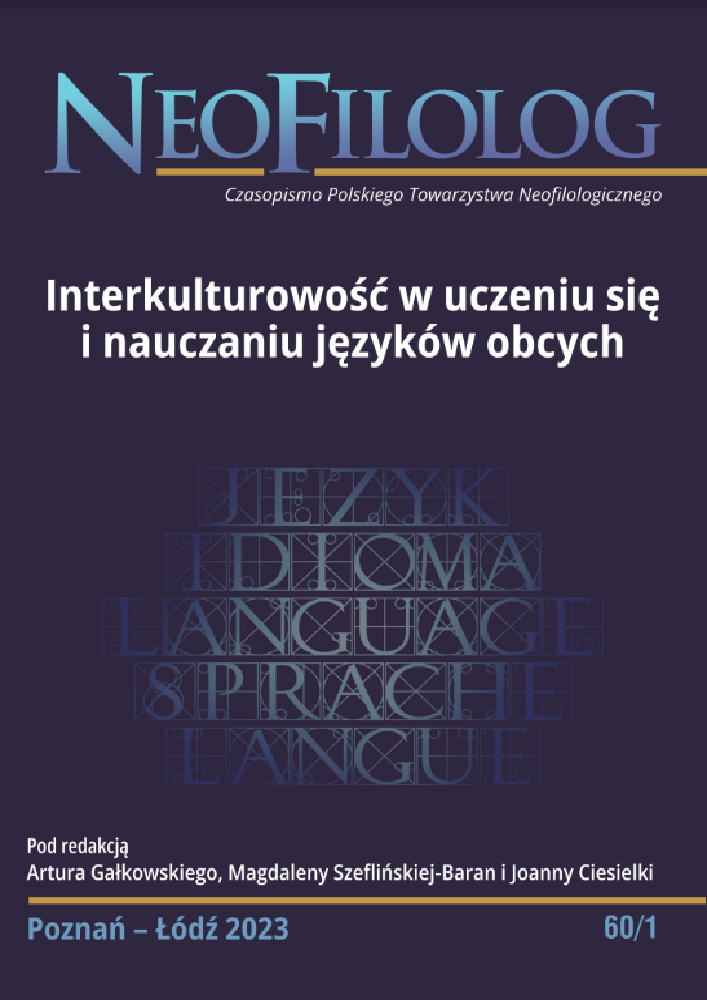Abstrakt
The learning of a foreign language cannot be carried out in the usual theoretical way, but it is necessary to broaden the scope, focusing on active praxis. In fact, it will be necessary to establish a basis that implies, on the one hand, the implementation of real elements of society and culture in the classroom and, on the other hand, that these elements are based on valid samples, which is what the CEFR-CV currently demands for the effective teaching of a language. Interculturality becomes an invaluable ally, given that in every situation in which it is possible to establish a direct relationship between the teaching of grammar from the perspective of active praxis and the linguistic realizations that result from this teaching action, we must observe that it is necessary to teach a language in which there are no predetermined models, having to attend to the habitual realizations used by native speakers in real interactions in all their variants and fields.
Bibliografia
Bachman, L. (2000). Habilidad lingüística comunicativa, (en:) Llobera, M. (ed.), Competencia comunicativa. Documentos básicos en la enseñanza de lenguas extranjeras. Madrid: Edelsa, 105-128
Balches Arenas, R. S. (2009), Las distintas competencias en el inicio del aprendizaje de ELE. La interlengua como mediación didáctico-cultural. “Studia Romanica Bratislaviensia”, nº 8, t. II, 7-20.
Canale, M., Swain, M. (1980). Theoretical Bases of Communicative Approaches to Second Language Teaching and Testing. “Applied Linguistics”, 1, 1-47. DOI: https://doi.org/10.1093/applin/I.1.1
Celce-Murcia, M., Dornyei, Z., Thurrell, S.: 1995, Communicative competence: A pedagogically moti-vated framework with content specifications, “Apllied Linguistics”, 6: 5-35. DOI: https://doi.org/10.5070/L462005216
Consejo de Europa (2002), Marco común europeo de referencia para las lenguas: aprendizaje, enseñanza, evaluación. Madrid: Secretaría General Técnica del MECD-Subdirección General de Información y Publicaciones / Anaya.
Consejo de Europa (2021), Marco común europeo de referencia para las lenguas: aprendizaje, enseñanza, evaluación. Volumen complementario. Madrid: Secretaría General Técnica del MEFP/ Instituto Cervantes.
Dandrea, F. B. (2015), El abordaje de los aspectos socioculturales en la enseñanza del español como lengua segunda y extranjera. “Signos ELE”, 1-12.
Fernández Jódar, R. (2021), El estudio contrastivo-pragmático entre primeras y segundas lenguas de los registros formal y coloquial. “Studia Romanica Posnaniensia”, 48(2), 77-86. [última consulta 31.12.2022]. DOI: https://doi.org/10.14746/strop.2021.482.007
Galindo, M. (2005), La importancia de la competencia sociocultural en el aprendizaje de segundas lenguas. “Interlingüística”, nº 16, 431-441. En línea: https://acortar.link/3bP9sK [última consulta 31.12.2022].
Gómez del Estal Villarino, M. (2016), Los contenidos lingüísticos o gramaticales. La reflexión sobre la lengua en el aula de E/Le: criterios pedagógicos, lingüísticos y psicolingüísticos, (en:) Sánchez Lobato, J., Santos Gargallo, I. (eds), Vademécum para la formación de profesores. Madrid: SGEL, 159-179.
Guillén, C. (2005), Los contenidos culturales, (en:) Sánchez Lobato, J. y Santos Gargallo, I. (eds.), Vademécum para la formación de profesores. Madrid: SGEL, 835-851.
Jensen, A. A. (1995), Defining Intercultural Competence. A Discussion of its Essential Components and Prerequisites, (en:) L. Sercu (ed.). Intercultural Competence. A New Challenge for Language Teachers and Trainers in Europe. Volume I: The Secondary School, Aalborg: Aalborg University Press, 41-52.
Méndez, M. C. (2015), La interculturalidad como elemento clave en el aprendizaje de lenguas, (en:) Actas del I congreso de español como lengua extranjera del Magreb (I CELEM), 20-26. En línea: https://acortar.link/iwBKZ3 [última consulta 20.09.2022].
Miquel, L., Sans, N. (2004), El componente cultural: un ingrediente más en las clases de lengua, “redELE”, nº 0, 1-13. En línea: https://acortar.link/4ZkMuA [última consulta 31.12.2022].
Santamaría, R. (2010), La competencia sociocultural en el aula de español L2/LE: una propuesta didáctica. Madrid: Secretaría General Técnica – Subdirección general de Documentación y Publicaciones del ME/ASELE.
Licencja
Prawa autorskie (c) 2023 Cecylia Tatoj, R. Sergio Balches Arenas

Utwór dostępny jest na licencji Creative Commons Uznanie autorstwa – Bez utworów zależnych 4.0 Międzynarodowe.
Przedstawiany utwór (artykuł) upubliczniany jest na podstawie umowy z autorem i na licencji Creative Commons Attribution-NoDerivatives 4.0 International (CC BY-ND 4.0).
Użytkownicy mają obowiązek podania wraz z rozpowszechnionym utworem, informacji o autorstwie, tytule, źródle (odnośniki do oryginalnego utworu, DOI) oraz samej licencji;
- bez tworzenia utworów zależnych,
- utwór musi być zachowany w oryginalnej postaci.
Uniwersytet im. Adama Mickiewicza w Poznaniu zachowuje prawo do czasopisma jako całości (układ, forma graficzna, tytuł, projekt okładki, logo itp.).

